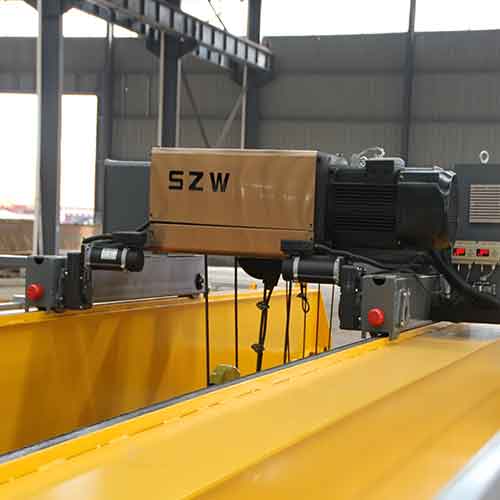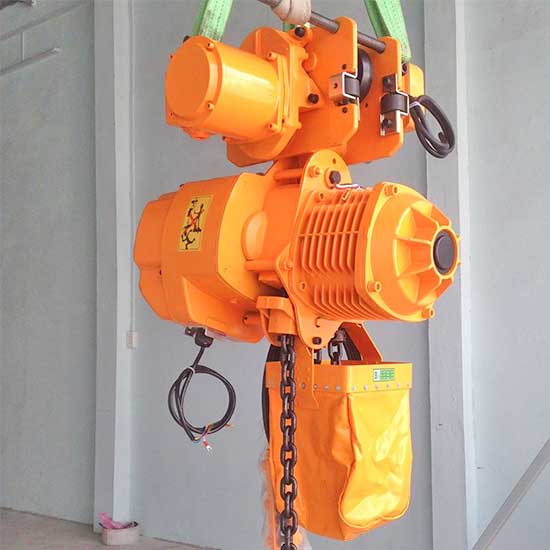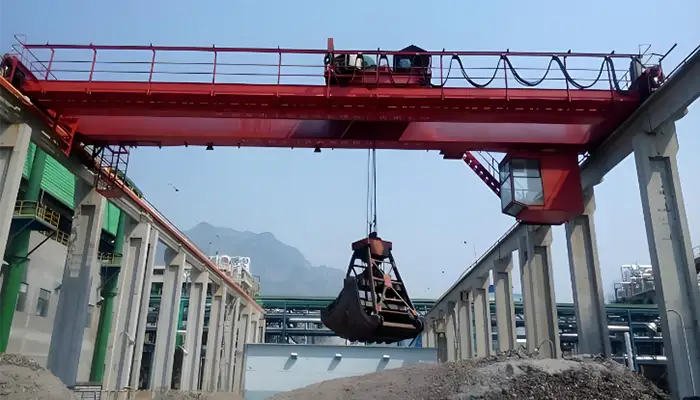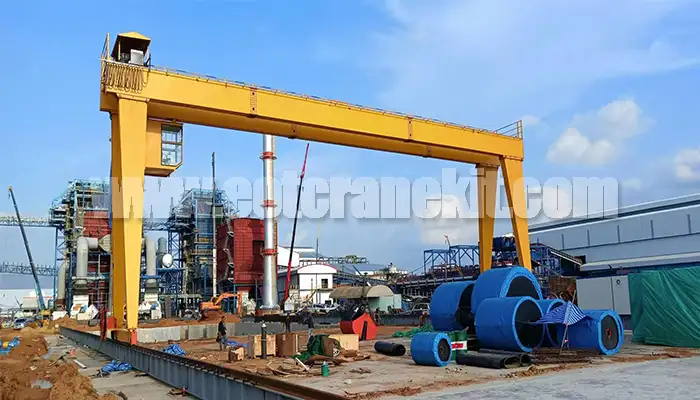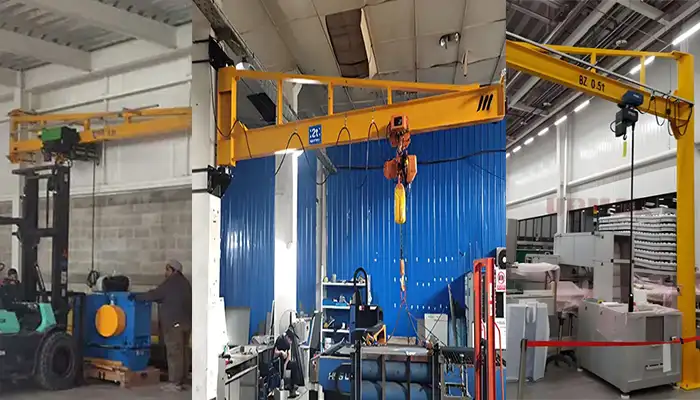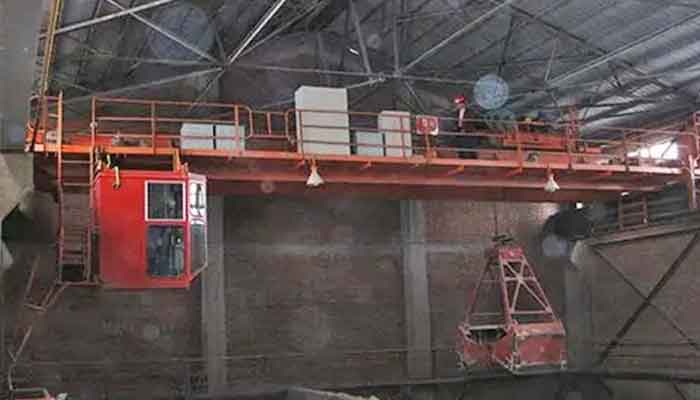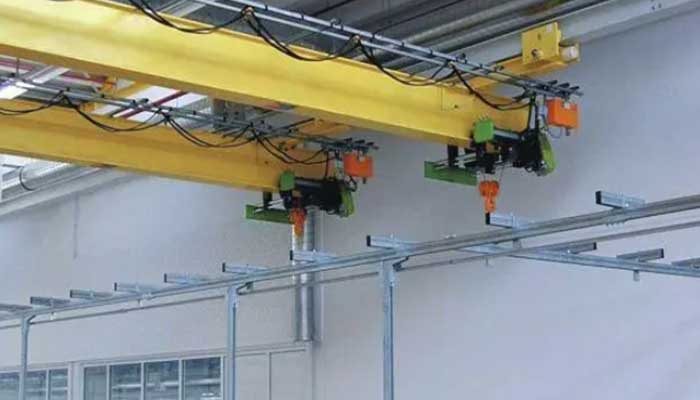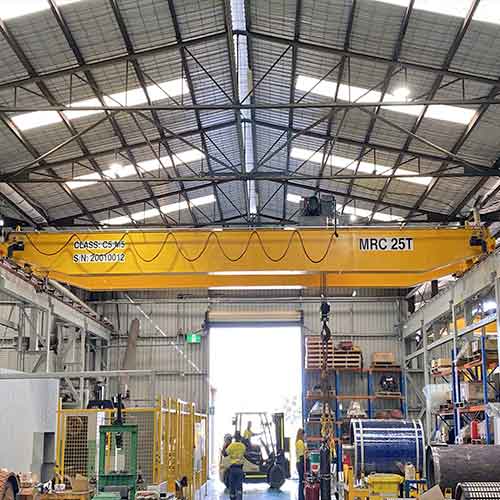Material Handling Hoist: Electric & Manual Hoist, Chain & Rope Hoist
Material handling hoist for sale. Types of chain hoists & rope hoists of different power supply, i.e. electric hoists, manual hoists, air hoists for sale.
Category: Overhead Crane for Your Use
Your Trusted Material Handling Crane and Hoist Manufacturer & Supplier
Material Handling Hoists, Types of Hoists for Material Handling
Electric Hoist, Manual Hoist, Air Hoist , Chain Hoist & Rope Hoist
We offer custom material handling equipment, including the overhead cranes, hoists, and their parts, etc. We produce and provide assembly supporting units for material handling cranes and hoists to make them more effective and suitable for their intended usage. We supply custom material handling equipment based on your requirements and lifting conditions.
Electric Hoist
The most popular type of materiel handling hoist is electric hoists. The lift capacity of these electric motorized hoists range from 250 lbs, which are available off-the-shelf, to 80 ton , which are often custom-engineered.
The duty cycle is used to rate all electric hoists. The material handling hoist's electric motor's rating affects how long it can operate before cooling down. As a result, an electric hoist with a 25% duty cycle can operate continuously for 25% of an hour, or 15 minutes, before cooling down.
Single speed, double speed & Variable speeds Electric Hoist for Material HandlingElectric hoists are powered by single-speed, double-speed, or variable-speed motors. The cheapest motors are those with a single speed; those with double and variable speeds have a few extra benefits. An operator of a double-speed hoist can lift a weight slowly at first and then gradually increase the lifting speed. This lessens the electric material handling hoist system's shock and increases the electric hoist's lifespan. In order to arrange loads more precisely and delicately, operators might slow the electric hoist near the end of a lift.
Electric hoists require a specific position in a facility since they are hardwired to a power supply. Wire rope and chain configurations are both available for electric hoists. Such electric hoist systems are now powerful and more durable thanks to advancements in the wire rope or chain used as the lifting medium.
Electric wire rope hoists and Electric chain hoistsElectric wire rope hoists are usually used to lift heavy loads. The motor turns a series of gears, which turn a grooved drum. The wire rope winds around the drum, turning it and lifting the load. Although these electric wire hoists have capacities of 80 ton , the popular capacity of 5 ton, 10 ton, 20 ton, 30 ton and 40 tons. They are frequently used for material handling operations such as the assembly of automotive equipment.
Electric chain hoists are also manually operated. An operator turns on the electric motor, which drives a set of gears and a lift wheel. Pockets in the lift wheel engage the chain links, raising the load as the chain passes over the wheel. The chain that comes off the wheel either hangs or is collected in a container beneath the hoist. Electric chain hoists for material handling range in capacity from 250lbs-35 tons. Electric c hain hoists provide true lifting hoisting but with slower lifting speed than than of electric wire rope hoists, despite being more maneuverable and smaller.
Electric wire rope hoist for material handling

Our European electric hoists are manufactured in capacities ranging from 1 ton to 80 tons as standard, and up to 320 tons with various speed and working-class options. Electric hoists are classified into stationary, monorail trolley, and double girder trolley hoists. Their compact design allows them to work in small spaces.
Our electric powered material handling hoists can operate continuously for a long period as a result of increased technological investments that were made under automated settings, as demonstrated by several tests. After thorough research by the technical team regarding the crane design that complies with global standards, the design of these electric hoists with modular, standard, easy maintenance and service capabilities has been finished. All trolley groups on wire rope hoists have been replaced with end carriages, and all end carriages have been improved to be direct drive type.
Headroom design of electric material handling hoists
The headroom of the hoist is one of the most crucial factors that crane users take into account, and we have managed to have one of the lowest headrooms. Using the unique control panel that was especially created with an ergonomic view. We are making a difference by enhancing the manufacturing processes and achieving high quality and efficiency in this way, as well as by performing risk analysis, a topic that is typically overlooked.
Tests of electric hoists
In a specifically constructed test station, all lifting machines produced are put through dynamic and static load tests in accordance with the applicable FEM and TS EN 15011 standard. The lifting gearbox's power and current levels, the overload protection limit value, etc. are measured during the Final Test phase. Around 70 essential control points were tested, and the test and control findings are documented in the Final Test Report and made available to the customer in the product technical file.

Electric Wire Rope Hoist
- Strong structure hoist body.
- Casting wire rope guide with springs.
- Optional ABM hoisting drives (contactor control or VFD control options).
- Horizontal movements are controlled according to VFD (Variable Frequency Drive) standards as optional.
- Hinged double girder trolley end carriages (sometimes referred to as "pivoted" or "jointed" in some publications).
- Electric load cell that prevents overload. Due to its electronic nature, there are several applications that can be created (digital load display, load-dependent speed control, etc.).
When required, a hoist can be controlled independently of the operator by a control panel with a PLC that provides basic Hoist Monitoring System data.

General Standard Features :
- Limit switches having two stages, minimum swing, and easy start and stop.
- Conformity with regional and global norms.
- Excellent construction for quick and simple maintenance.
- Quiet, strong, and advanced design.
- The hoist motor thermal contact.
- Intelligent control panel.
- Phase sequence and phase failure control delay.
- Hoist motor protection switches.
- Direct drive end carriages group.

Monorail Electric Wire Rope Hoist
Our Monorail Hoists have one of the lowest headroom is in the industry, allowing us to increase the height of the hoisting lift with capacities ranging from 1 ton to 12.5 tons. There are two options for hoisting speed: variable speed or double speed (High/Low).

Double Girder Electric Wire Rope Hoist
Our double girder hoist has lifting capacities ranging from one to eighty tons, multiple lifting speed options, and FEM Class. Variable speed or two speeds (High/Low) (Inverter)

Foot Mounted Electric Hoist
Fixed / foot mounted hoists made by us have a 80 ton capacity.

Special Design Hoist
If you need a hoist with a different capacity, speed, or working-class specification than what is offered in the standard products, we are able to design a custom solution for you. This work is done by our technical team in accordance with the relevant requirements.
Electric Chain Hoist for Material Handling
The electric chain Hoist provides true vertical lifting and with a high level of security. In many instances, the ergonomic and small designs ensure simple and trouble-free use. Work productivity is improved by the incredibly simple operation and minimal maintenance requirements. Coupled with the extended life's lowest installation and operational costs. It will always be the product of choice.
Manual Hoists
The smaller, slower manual hoists are typically employed for maintenance and other one-time jobs because they are portable and small. Hand-chain and rachet-lever hoists are inexpensive manual lifting tools that work incredibly well at simple tasks.
Two chains are used in hand-chain hoists: a pull chain and a chain connecting to the load. The internal gears of the hoist rise and lower the lift chain when an operator pulls the pull chain, giving the hoist a mechanical advantage that makes lifting easier. Although these hoists can raise loads of up to 70 tons, the majority of the market is for loads under 5 tons.
Chain or wire rope can be used with ratchet-lever hoists. They operate similarly to hand chain hoists but rotate the sprocket that engages the lifting mechanism using a lever as opposed to a pull chain. Rake-lever hoists are ideal for low-lift applications, which are frequently less than 5 feet in height, with capacity ranges from 500 pounds to 9 tons. Rachet-lever hoists are more frequently employed for pulling jobs than for lifting; they may raise vertically and pull horizontally.

Chain block

Rachet chain hoist

Explosion proof chain block

Low headroom hoist
Air-driven Hoists and Winches
Air driven hoists (also known as pneumatic hoists) do not use electric motors, do not require electricity, and do not overheat. Because they can be used continuously and don't require the cooling period that electric hoists do, they can be used to facilitate highly repetitive assembly line applications. These hoists are perfect for mass production, assembly lines, and foundries.
The lifting medium in the majority of air-driven hoists is chain. They work similarly to electric chain hoists, but they are not hardwired into an electrical system.
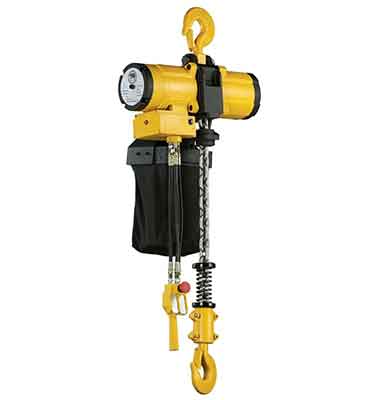
Hook mounted air hoist for material handling
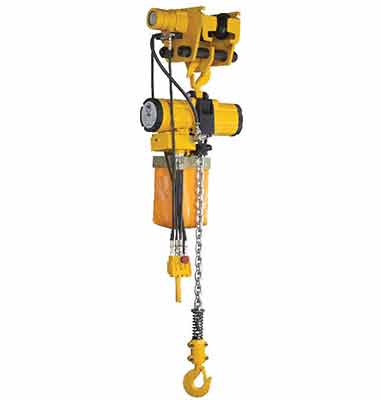
Trolley travelling air hoist in material handling
FAQ of Material Hoist: What is a material handling hoist?
A hoist is a device for lifting or moving materials. A drum (or wheel) on which a rope (wire or fiber) or chain is wrapped provides the lifting force.
Hoists are classified as electro-hydraulic, manual or lever operated, base mounted, or pendant cranes. These hoists move differently, but the precautions that must be taken when working with them are similar. Always adhere to the manufacturer's recommendations when using a hoist.
What are material handling hoists used for ?
Material handling hoists are used in a variety of industries, not just those that are manufacturing-related. hoists, for example, lift freight, building materials, engines, and warehouse goods.The lifting hoists are commonly used for the following purposes:
- Building sites: material handling hoists are a crucial component of building construction operations. They facilitate easy worker movement of heavy loads from the ground level up into position.
- Warehouse operations: Moving and carrying heavy objects and materials are necessary for warehouse operations. The material handling hoists are therefore frequently employed in these circumstances.
- Manufacturing line tasks: material handling hoist mechanisms in production lines move finished goods or raw materials between phases of the assembly process. These procedures call for accurate movement at the appropriate moment and place. This means they must be operated by competent individuals who can accurately undertake difficult duties.
What are the different types of hoist lifting systems, mediums and suspension?
- Electric Wire Rope Hoist: The most common type ofmaterial handling hoist is the electric wire rope hoist. The lifting motion is powered by an electric motor. They also have a variety of features, such as multiple speeds and safety mechanisms.
- Chain Hoist : Chainhoists are similar to electric wire ropehoists, but they move the load with a chain rather than cables. They are commonly used in manufacturing plants because they can support more weight and are less expensive than other types ofmaterial handling hoists.
- Pneumatic / Air-powered : Compressed air is used to power the lifting motion in pneumatichoists. They come with a variety of features, including adjustable speeds and overload protection devices, and are frequently used in confined spaces where electric or chain hoists cannot fit.
- Manual hoist: Hand-operated manualmaterial handling hoists work best for light-duty applications. When a power source is not conveniently accessible, they are frequently used in manufacturing and construction environments.
Depending on what you need to lift or move, the type of system that will work best for your industrial overhead crane and hoist needs. Different lifting system suspensions are available in addition to different material handling hoist types.
Suspension types of material lifting hoist
- Hook mounted: A hook mounted system is one in which thehoist is attached to crane hooks. This hook suspensionhoist system is commonly used in the manufacturing and transportation industries.
- Trolley Mounted: Trolley mounted suspensions are used in applications where loads must be moved both vertically and horizontally. They are similar to hook mounts in this regard. The lifting medium (or what is being lifted) is connected to a carriage that travels along a track. This system is frequently combined with electric or chainmaterial handling hoists.
- Lug mounted: For lifting loads that are too big or heavy for trolley mounted systems, lug mounted suspensions are used. The lifting medium is directly attached to the suspension system, which is then suspended from the crane hooks.
Within each of these three categories, there are a variety of different material handling hoist suspension types. To determine what will work best for your needs, consider the weight and size of the load you're trying to lift, as well as the space constraints of your work area.
Lifting medium types of material hoist
There are several types of lifting mediums that can be used in conjunction with material handling hoists. Your needs and the materials the crane will most frequently lift will determine the kind you choose.
- Wire Rope: Made of strands wrapped around a central core, wire rope is strong enough to withstand heavy loads without breaking. Because it is sturdy and is simple to modify to meet your application's requirements, it is frequently used in cranes and other overhead lifting systems.
- Welded Link Load Chain: Welded link load chains are formed by welding together links to form a continuous loop. They're used in manualmaterial handling hoists because they don't need to be maintained and can be adjusted as needed without the use of tools or equipment.
- Roller Load Chain: Roller load chains are made up of small rollers that help to evenly distribute the weight of the load. As a result, the chain is kept in good condition and handling heavy loads is made simpler. Since they can support more weight without breaking, they are frequently found in pneumaticmaterial handling hoists.
When should you inspect the materials hoists?
- Daily check for wear and damage on hooks, ropes, brakes, and limit switches.
- Ensure that the higher and lower hooks can swivel before lifting a load. Any chain or wire rope that is worn, harmed, or corroded must be replaced right away. Every broken chain or rope should be marked and taken out of service.
- Periodically, or as instructed by the manufacturer or by the rules that apply.
- Plan a thorough examination of each hoist.
- Follow the recommended maintenance regimens provided by the manufacturers.
- Replace anything that isn't working properly. Items with defects should be marked and taken out of service for professional repair.
- Verify that the hoist is marked with the safe load limit.
How should you use a materials hoist safely?
- Know the hoist's safe load limit. Do not go beyond.
- Keep chains and wire ropes greased.
- Lift the burden from directly above. The load may sway when lifted if it is not level.
- Hang hoists firmly in the section of the hook that is the tallest. This rigging places the hook support parallel to the hook shank.
- Any direction can be pulled with lever-operated hoists, but a straight line draw is required. Side pulling or raising puts unsafe amounts of force on the hoist parts and accelerates deterioration. Hand, chain, and lever hoists should only be pulled by one person at a time.
 Pushing a loaded hoist is safer (A). If it must be pulled, use a rope (B).
Pushing a loaded hoist is safer (A). If it must be pulled, use a rope (B).- Stand entirely clear of the weight.
- Place the load in the hook correctly.
- Smoothly move the hoist controls. Avoid moving the load in rapid, abrupt motions. Before lifting the cargo, tighten the hoisting and sling ropes.
- Before beginning the lift, remove all loose components, packing, materials, and obstructions from the load.
- Before beginning to hoist, make sure everyone is far enough away from the burden.
What should you avoid when using material hoists?
- Never lift individuals with hoisting machinery.
- Never transfer a load to a worker.
- Never tip a load. When the load is unsteady, the hook and hoist are damaged.
- Never place the hook's point inside a chain link.
- Never pound a sling into position.
- Slings should not hang from the load hook. While hauling slings to the load, mount the sling hooks on the sling ring.
- To clear obstructions, don't lift loads higher than necessary.
- Never go over a hoist load limit.
- Don't leave cargoes that are suspended unattended.
What to consider when choosing a material handling hoist ?
With so many different types of material handling hoists available, it's critical to select the one that will best suit your needs. Here are a few things to think about when selecting the best one:
- Lifting capacity: The maximum amount of weight that the material handling hoist can lift without breaking. Before buying a hoist for your application, make sure you understand the capacities of the various types available.
- Travel distance: This is the distance that the material handling hoist must travel in order to complete its task. It might be unable to lift the required amount of weight if the travelling distance is too far.
- Ease of use: An easy-to-use hoist will make things much easier, especially if you're not used to using one on a regular basis. Before making a purchase decision, it may be worthwhile to invest in additional training or research what type of equipment will best suit your needs.
- Safety features: Check that the hoist has all necessary safety features and is kept in good condition so that it won't malfunction on the job site. If you want to ensure that the material handling hoist is in good shape, think about keeping a crane safety checklist on hand.
- Operating time and frequency: How frequently will the hoist be used? How long will it take each time? These are important considerations when purchasing a hoist, as some require more frequent maintenance than others.
- New vs. old hoist: When looking for a replacement material handling hoist, it's critical to understand the distinction between new and old models. Old hoists may be less expensive but require more maintenance, whereas new hoists typically have more features and are simpler to use.
- Operator of a crane or hoist: It's important to find someone who is skilled in using a crane or material handling hoist if you aren't. Before giving them control of your equipment, make sure they are qualified and understand what they are doing.
- Others to condister: Assignment of costs or the budget. Usability. Location and environment. Safety. Hardiness or dependability. The availability of labor for operation and maintenance. Availability of spare components. Warranty and post-purchase support.
When you are familiar with every component and know what to look for in a material handling hoist, you are prepared to buy.
We encourage you to contact us for solutions for your cranes and material handling equipment if you are unsure of the specification that is best for your operation. We would be honored to create your crane.
Main Projects
Related Products
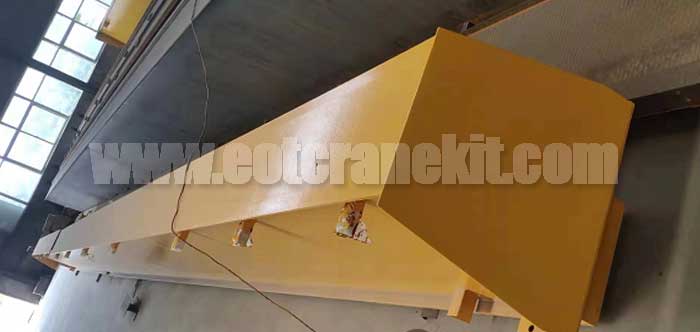
6.3 ton overhead crane kit for sale Philippines, complete single girder top running overhead crane system, low headroom design for workshop indoor use.
Free consultation to Confirm Parameters & Specifications and Get
Latest Crane Price & Crane Rate.
- Types of overhead cranes : _______?
- Optional: Overhead travelling crane, goliath gantry crane,Slewing jib crane, Single girder or double girder crane,small portable crane or kbk crane, etc.
- Capacity of overhead crane: _______?
- Optional: 0.25ton, 0.5 ton, 1 ton, 2 ton, 3ton, 5 ton, 10 ton,15ton, 20ton, 25 ton, 30ton,35ton, up to 550ton, etc.
- Crane span & lifting height : _______?
- Crane travelling length : _____?
- Control of overhead crane:_______?
- Optional: pendant/ remote/cabin control
- Voltage supply of overhead crane:_____?
- Eg,: 380V50/60HZ,3Phase or others,etc.
- Application/usage of crane:_______?
- Eg,: Steel mill, ,injection mold, cement,stone, concrete,granite, general manufacturing, etc.
Just leave a message via the contact form and our hoist and crane engineer will contact you with in 24working hours.
Get In Touch
